By Gwen Wion, Fort Collins Nursery Employee

June is National Pollinator Month, making this the perfect time to appreciate the pollinators in our backyards. Without them, our vegetable gardens would not produce vegetables. The flowers on our fruit trees would wither and fall without ripening into delicious apples and peaches. Since plants can’t move, many rely on insects to transfer pollen from the anthers (male parts) to the stigmas (female parts) of their flowers to produce fruit. This is particularly important for plants that are not self-fruitful and need a nearby partner to exchange pollen with to set fruit (such as apples, sweet cherries, elderberries, pears, and others!). That said, pollinators are not in it to provide us with food. Plants produce flowers to entice insects to collect their protein rich pollen and sugary nectar as food. Incidentally, as they hop from flower to flower gathering food, they often accidentally leave some of the pollen they have gathered on the stigma of a flower, resulting in pollination! While many types of insects act as pollinators, bees are valued as the most efficient insect pollinators because they collect and feed exclusively on pollen and nectar.
While most folks are familiar with honeybees, some may be surprised to learn that these bees are not native to North America. These social bees were introduced from Eurasia and have become essential to crop production around the world. While honeybees have become integral to our North American ecosystems, it’s worth taking a minute to highlight and appreciate our native bee diversity. There are about 4,000 bee species in the United States and 950 of them are known to live in Colorado.
Bumblebees

Honeybee colonies are kind of like perennials, living in colonies that persist for multiple years and storing honey to eat as food in the winter months when flowers are scarce. In comparison, bumble bees are like annuals. Bumblebee queens emerge from underground overwintering locations in the early spring to initiate their colonies. As a result, most bumblebees that you see in April or May are large queens, who can often be seen flying close to the ground and exploring crevices as they search for the perfect place to start their colony. The location of her colony is a very crucial decision for the queen because if it is too large, she will not be able to adequately incubate her eggs during spring frosts. If it is too small, it will not accommodate her growing colony throughout the summer.
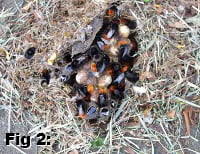
Due to their large size, bumblebees can generate heat by vibrating their flight muscles, which are also responsible for the loud buzzing they make when they fly. Bumblebees are particularly important for pollinating certain types of plants, such as tomatoes, peppers, and blueberries. These plants evolved with bumblebees and have specialized stamen, which only release pollen when vibrated at a specific frequency. This frequency matches that which is produced by bumblebees when they vibrate their flight muscles, making them the most efficient pollinators of these crops. Bumblebee colonies are active into the fall, when they begin producing the next generation of queens. These queens mate and find a snug underground location in which to overwinter, so that they may emerge the next spring and start the cycle again.
Solitary bees
Solitary bees make up the vast majority of bee species worldwide. Instead of forming organized colonies with specialized roles that last the duration of the growing season, each of these bee species are only active for a few weeks of the year. The life history specifics of solitary bees vary; Some inhabit and lay their eggs in holes in the ground, others occupy old stumps or the hollow twigs of brambly berry plants. Nesting location aside, they all follow the same general life history steps. They emerge, mate, and then lay eggs that will emerge as bees the following year. Nesting chambers consist of a repeating pattern of egg, food provision (a mixture of pollen and nectar often referred to as bee bread), and then a wall that separates each nursery chamber.
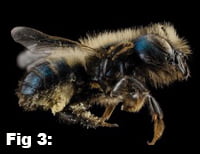 | 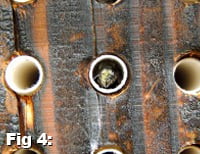 |
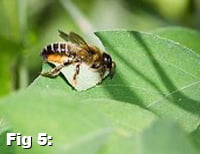 | 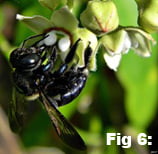 | 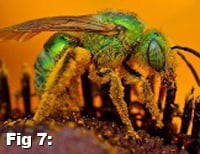 |
While most bees are not picky about the types of flowers they visit, there are some notable exceptions. Some species of bees have evolved to become very efficient pollinators of specific groups of plants. Squash bees, for example, are specialists on Cucurbita (i.e. pumpkins, cucumber, zucchini, and other squash). If you grow any of these vegetables, you will find these specialists visiting your garden. The males of these types of bees often sleep in squash flowers, so it is worth peeking inside the flowers to catch a glimpse of these sleepy bees.
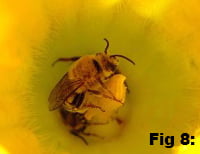
Gardening for bee diversity: Plant flowers!
Urban gardens can provide great habitat for native bee species. Since most bee species are only active for a few weeks out of the year, having flowers around to serve as a food source throughout the growing season is the best way to support native populations.
Figure 1: Hunt’s bumblebee is one of the most common front range bumblebee species. Photo from USGS Native Bee Inventory and Monitoring Laboratory from Beltsville, USA – Bombus huntii, M, side, Pennington County, SD_2012-11-14-15.41.21 ZS PMax
Figure 2: A bumblebee nest with visible honey pots. Waxen honey pots are created and used to store nectar. If you have a bumblebee nest on your property, consider whether you are able to let it be rather than removing it, since they are unlikely to cause problems and will only last the duration of one growing season. Bumblebee populations are declining across the country and it is important to foster wild populations when possible! Photo from Phelyan Sanjoin – Flickr: DSCF0390.JPG
Figure 3: Mason bees are common North American solitary bee species, which are valued as important pollinators of apple, almond, and other fruit trees because the timing of their emergence overlaps with flower timing of these fruit trees. Photo from https://www.flickr.com/photos/usgsbiml/12330401803/in/album-72157662664810804/
Figure 4: Mason bees build their nests in holes in wood and can be managed by farmers who deploy bee houses, as pictured above. Photo of mason bee in bee hotel. Photo by and used with permission of John Mola.
Figure 5: Leafcutter bees seal their nesting chambers using bits of leaves that they collect. If you notice half moon shaped holes on the edges of leaves in your garden, it is likely a leafcutter bee collecting material for her nest. Instead of using pesticides or other deterrents, it is best to let these bees collect the materials that they need. Because they are only active for a short time of the year, they are unlikely to cause any real damage in your garden. Photo from Bernhard Plank – http://leetsil.fh-forum.org/index.php/2008/beitrage/insektenhotel/ID83/insektenhotel-solitarbiene-blattschneiderbiene-megachile-centuncularis-l.html
Figure 6: Carpenter bees use their impressive mandibles to tunnel into wood to make nests. Though carpenter bees follow a solitary bee’s life history, they can be found building and sharing nesting tunnels with sibling (sister) bees. Scientist’s call this kind of social behavior ”gregarious.”
Figure 7: Sweat bees are solitary, ground nesting bees. They are named so because of their attraction to the salt we excrete when we sweat. It is not uncommon to find one of these bees gently collecting salt from our skin. While sweat bees can sting, their sting is very small in comparison to a honeybee’s and they are not likely to sting unless provoked. If you catch one of these beautiful insects on you, you can gently encourage it to leave (or if you are comfortable with it, allow it to collect the salt that it is after!).
Figure 8: A male Peponapis pruinosa squash bee in a squash flower. Photo courtesy of USDA-ARS Bee Biology and Systematics Lab.
Originally published on June 1st, 2021.
